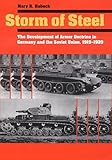Storm of steel : the development of armor doctrine in Germany and the Soviet Union, 1919-1939 / Mary R. Habeck.
Material type: TextSeries: Publication details: Ithaca, N.Y. : Cornell University Press, (c)2003.Description: 1 online resource (xvii, 309 pages) : illustrationsContent type:
TextSeries: Publication details: Ithaca, N.Y. : Cornell University Press, (c)2003.Description: 1 online resource (xvii, 309 pages) : illustrationsContent type: - text
- computer
- online resource
- 9780801471391
- UE159 .S767 2003
- COPYRIGHT NOT covered - Click this link to request copyright permission: https://lib.ciu.edu/copyright-request-form
| Item type | Current library | Collection | Call number | URL | Status | Date due | Barcode | |
|---|---|---|---|---|---|---|---|---|
 Online Book (LOGIN USING YOUR MY CIU LOGIN AND PASSWORD)
Online Book (LOGIN USING YOUR MY CIU LOGIN AND PASSWORD)
|
G. Allen Fleece Library ONLINE | Non-fiction | UE159 (Browse shelf(Opens below)) | Link to resource | Available | ocn887802634 |
Includes bibliographies and index.
The unfinished machine, 1919-1923 -- Materiel or morale: the debate over the mechanization of warfare, 1923-1927 -- Technology triumphant early German-Soviet collaboration, 1927-1929 -- Consensus and conflict, 1930-1931 -- A new confidence: the end of collaboration, 1932-1933 -- Trading places, 1934-1936 -- The evidence of small wars armor doctrine in practice, 1936-1939.
In this fascinating account of the battle tanks that saw combat in the European Theater of World War II, Mary R. Habeck traces the strategies developed between the wars for the use of armored vehicles in battle. Only in Germany and the Soviet Union were truly original armor doctrines (generally known as "blitzkreig" and "deep battle") fully implemented. Storm of Steel relates how the German and Soviet armies formulated and chose to put into practice doctrines that were innovative for the time, yet in many respects identical to one another. As part of her extensive archival research in Russia, Germany, and Britain, Habeck had access to a large number of formerly secret and top-secret documents from several post-Soviet archives. This research informs her comparative approach as she looks at the roles of technology, shared influences, and assumptions about war in the formation of doctrine. She also explores relations between the Germans and the Soviets to determine whether collaboration influenced the convergence of their armor doctrines
COPYRIGHT NOT covered - Click this link to request copyright permission:
There are no comments on this title.
